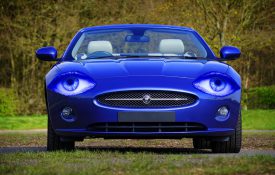-
A Psychological Solution Prevents Rubbernecking
People just can’t seem to help themselves when it comes to gawking at accidents and car crashes. Rubbernecking—or slowing down to scope out an accident on the side of the road—is a major cause of traffic jams. The bright lights and colors on emergency response vehicles are designed to grab people’s visual attention. But, these attention-grabbing qualities can also make scenes on the side of the road unintentionally distracting for drivers. As part of an effort to keep drivers’ eyes on the road and feet on the gas pedal, the government in the UK is already investing in incident screens to block drivers’ wandering eyes.
-

Similarity to Human Drivers Inspires Trust in Self-Driving Cars
A study explores whether giving artificial intelligence a more human face, in the form of a virtual driving agent, would help increase people’s trust in smart driving systems. Visit Page
-
Cognitive Costs of Crossing the Street Increase with Age
On average, a pedestrian in the US is killed in a car-related accident every 2 hours and injured every 7 minutes, according to data from the Centers for Disease Control and Prevention (CDC). But children aren’t the ones at greatest risk of a deadly collision with a car– seniors are. A CDC analysis of pedestrian traffic deaths from 2001-2010 concluded that the risk of death actually increases with age. Children under age 15 had the lowest risk of dying as the result of a collision with a vehicle; people over the age of 75 were more than twice as likely to be killed by a car compared to pedestrians overall.
-
Why People Buckle Up in Cars, But Not in Cabs
In May, Nobel Prize-winning economist John F. Nash Jr. and his wife Alicia were tragically killed in a car accident on the New Jersey expressway. Investigators reported that they were not wearing seat belts at the time, and died after being thrown from the backseat of their taxi. Whether you’re in the front or back of a car, wearing a seat belt is often the most effective way to prevent serious injury in case of an accident. Yet, in some situations -- such as riding in the back of a cab -- people are far less likely to buckle up. In New York City, taxi drivers and their passengers are exempt from laws regarding car seats and seat belts.
-
Fighting Crime, One License Plate at a Time?
You’re driving down the street when you witness a hit-and-run incident between two other cars. The offending driver speeds off before you have a chance to jot down their license plate number. You’ve only had a few seconds to memorize the plate but you know that the more you can remember, the more likely police are to nab the hit-and-run driver. This is no small feat. Vanity plates aside, the seeming arbitrariness of the letters and numbers that grace most license plates makes them tricky to memorize on the spot.
-

The Seduction of a Sunny Day: How Weather Biases Car Buying Behavior
An analysis of 40 million car sales reveals the weather on the day of purchase can bias buyers towards choosing a car they may later regret. Visit Page

